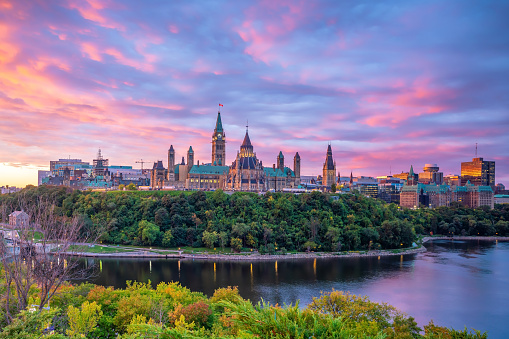
Parliament Hill in Ottawa, Ontario, Canada at Sunset
What It’s Like to Live in Ottawa
If you’re looking to move to Ottawa, there are some facts you should know! Ottawa, Canada’s capital city, is located in the southeastern region of Ontario on the south bank of the Ottawa River. Approximately 790 miles long, the Ottawa River played a large part in the settlement and development of the city, as it assisted in the transport of resources from the Ottawa area, including furs, timber, and minerals. Later on, it became in resource in the production of hydroelectric power for the city and an asset to the growth of the industry. Ottawa’s metropolitan area spans the Ottawa River. The city’s continental climate features warm, humid summers and cold, snowy winters. Temperatures average about 10 °C in January and 20 °C in July.
Ottawa is filled with celebrated cultural institutions, including the National Gallery of Canada, the Canada Science, and Technology Museum, the Canadian War Museum, the Diefenbunker Museum, the Canada Aviation, and Space Museum, and the Bytown Museum. The national archives can be found at the Library and Archives Canada. Other notable attractions include the Parliament Buildings, Parliament Hill, ByWard Market, and Sparks Street, the first outdoor pedestrian mall in Canada. The Rideau Canal was named a UNESCO World Heritage site in 2007. Throughout the winter months, when the canal freezes over, it becomes the world’s longest skating rink, a popular pastime for locals, and a fixture of Ottawa’s Winterlude festival each February. The Canadian Tulip Festival takes place in May, while July 1st sees the largest Canada Day celebration in the country. The summer months are filled with music festivals and farmers’ markets. With a vibrant culinary community, eclectic shopping options, and the great outdoors at your fingertips, the possibilities for entertainment and recreation are endless.
The city’s largest employer is the federal government, including institutions such as the Bank of Canada, the Royal Canadian Mint, the Supreme Court of Canada, and the Queen’s Printer. Many other job opportunities can be found in the technology sector as there are thriving companies in the areas of biotechnology, telecommunications, software, wireless, defence, and security. Ottawa is also home to the headquarters of embassies, trade groups, and commercial and financial associations. The economy centers on the two major sectors of technology and the federal government, as they account for 37% of Ottawa’s total gross domestic product.
As of 2016, Ottawa’s population was estimated at 934,243. The census metropolitan area is estimated to be about 1.25 million, making it the fourth-largest metropolitan area in Canada. At first, the city was an Irish and French settlement but now boasts an incredibly culturally diverse population, as about 24% of residents are foreign-born.
Demographic Breakdown:
Estimated median household income: $85,981
Median resident age: 40years
Estimated median house or condo value: $397,495
Median gross rent in 2016 for apartments: $1,173
Sources:






